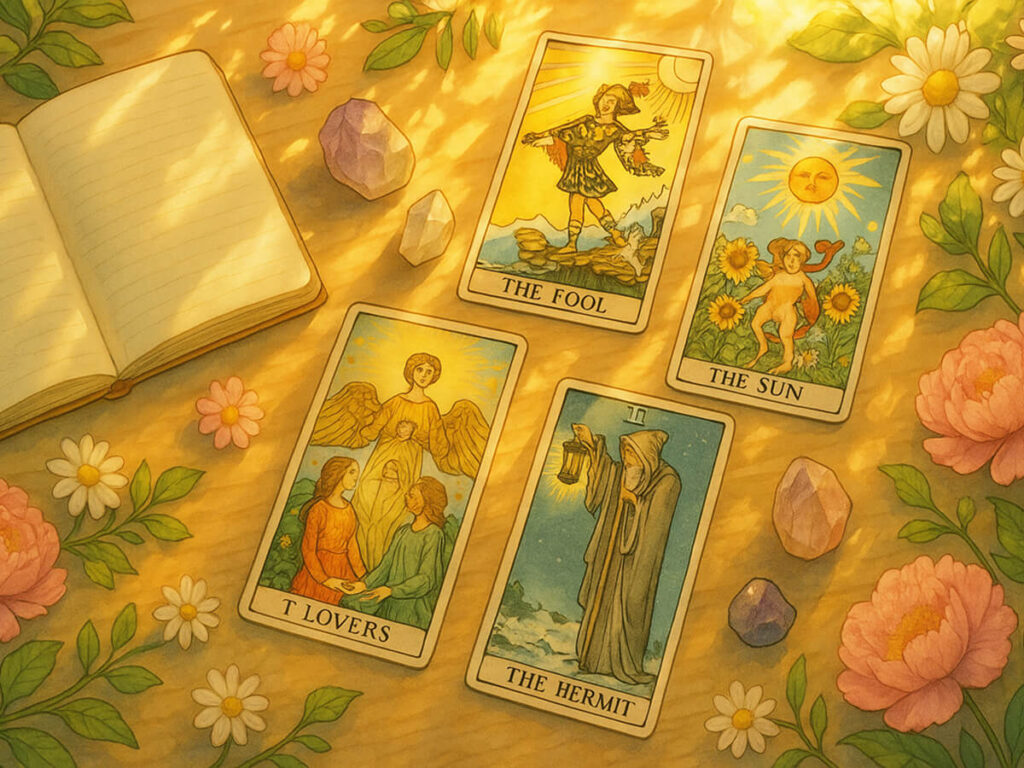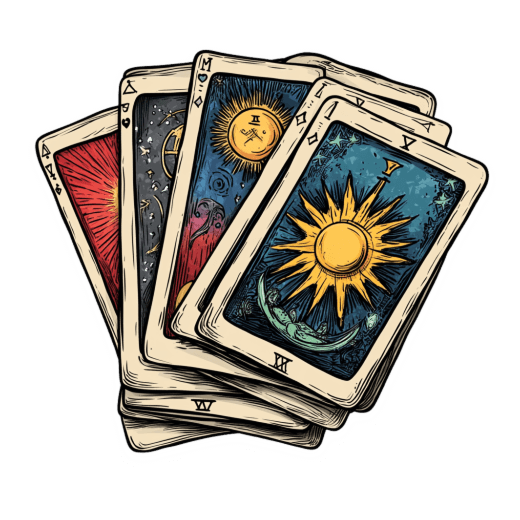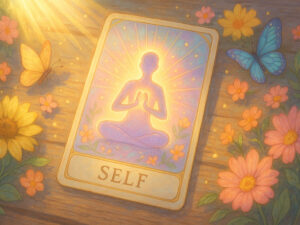How to Use Tarot for Personal Growth


Table of Contents
Hello there, seekers. Miranda Starr here. After decades spent peering into the mysteries with my tarot cards, helping folks find their soulmates and navigate life’s twists, I’ve learned a thing or two. One of the biggest surprises? Tarot isn’t just about predicting what’s around the corner. Honestly, that’s selling it short. Its real magic, the deep stuff, lies in tarot for personal growth.
Now, I know what some of you might be thinking. Tarot? Isn’t that all crystal balls and spooky predictions? I remember a young woman coming to me years ago, absolutely terrified she’d pull the Death card. We’ve all seen those dramatic movie scenes, haven’t we? But let me tell you, based on over forty years of experience, that’s mostly Hollywood fluff. Tarot, at its heart, is a profound tool for self-discovery and introspection. Think of it less like a crystal ball and more like a mirror, reflecting back the inner wisdom you already possess but maybe haven’t quite tuned into yet.
It’s funny, the cards themselves started as a simple game back in Renaissance Italy! It wasn’t until later that people started seeing their potential for deeper self-reflection. They don’t hold the answers, locked away like secrets. Instead, the rich symbolism and archetypes on each card act as prompts, nudging your subconscious and helping you see your life, your challenges, and your potential from a completely new angle. It’s about understanding yourself, right here in the present moment. It’s a powerful way to practice mindfulness and build that crucial connection to your own intuition. Forget the spooky myths; let’s explore how these beautiful cards can become your trusted companions on your personal development journey. We’ll delve into how tarot journaling and tarot meditation can unlock insights, and even touch on shadow work prompts for deeper self-awareness. Ready to look within?
Beyond Fortune-Telling: Discovering Tarot for Personal Growth
So, we’ve established that tarot is more than just predicting lottery numbers, right? Good. Because honestly, the most profound experiences I’ve witnessed – and had myself – with these cards have nothing to do with seeing the future. It’s about understanding the now. It’s about using tarot for personal growth, a concept that sometimes gets lost in the shuffle, pardon the pun.
I remember when I first started, oh goodness, must be over forty years ago now. I was drawn to the mystery, like many are. But the real shift happened when I stopped asking “What will happen?” and started asking “What does this mean for me, right now?” That’s the core of using tarot as a mindfulness tool. It pulls you right into the present moment, asking you to look at the symbolism on the card and see how it reflects your inner world, your feelings, your challenges.
Think about the Major Arcana – The Fool, The Magician, The High Priestess. These aren’t just pictures; they’re powerful archetypes, representing universal human experiences and stages of our personal journey, as noted in many texts exploring psychological tarot. When The Hermit shows up, maybe it’s not predicting loneliness, but suggesting a time for introspection and seeking inner guidance. The Tower might feel jarring, sure, but perhaps it’s highlighting a structure built on faulty foundations that needs to crumble for personal transformation to occur. It’s about self-reflection, not rigid prophecy.
It’s fascinating how these cards work on our intuition. You look at the imagery, maybe the traditional Rider-Waite-Smith deck or something more modern, and something just… clicks. A feeling, a memory, a sudden understanding. That’s your inner wisdom responding! The cards act like a key, unlocking doors within your subconscious that you might not even know were there. It’s not magic in the hocus-pocus sense, but the magic of self-awareness.
We get so caught up in the day-to-day, don’t we? Worries about the future, regrets about the past. Tarot gently encourages us to pause. To breathe. To connect with ourselves. The benefits? Oh, they’re immense. Increased clarity, better problem-solving, a deeper understanding of your own patterns (the good and the not-so-good!), and a stronger connection to your authentic self. It’s a pathway to empowerment, helping you navigate life with more consciousness and grace. It’s a beautiful form of self-care, really. A way to check in and honor your own spiritual growth. Forget fortune-telling; this is about discovering the fortune that already lies within you.
Your Inner Compass: Tarot Journaling & Meditation Practices
Alright, so you’re starting to see tarot as more than just a party trick. Wonderful! Now, let’s talk about how to actually use it day-to-day for that juicy personal growth. Two of my absolute favorite methods, ones I’ve relied on for years, are tarot journaling and tarot meditation. Think of these as ways to tune your inner compass.
Tarot journaling… ah, it’s like having a conversation with your soul, with the cards as prompts. Many experienced readers find this practice invaluable for tracking personal patterns and deepening self-understanding. I remember feeling a bit lost after a big life change decades ago. I started doing a simple daily tarot draw – just one card each morning. I’d ask something simple like, “What energy do I need to focus on today?” or
“What lesson is presenting itself?” Then, I’d just write. No judgment, just stream-of- consciousness thoughts sparked by the card’s image. Sometimes I’d look up the tarot card meanings, other times I’d just go with my gut intuitive reading. It’s amazing what comes up when you give yourself that space for self-reflection! You start noticing patterns, connecting dots. Maybe the Ten of Swords keeps appearing, not as a prediction of doom, but as a sign you need to let go of a victim mentality. That introspection is priceless.
You don’t need fancy spreads, especially at first. A one-card draw is powerful. Or try a simple three-card spread: Situation, Action, Outcome (focused on growth, remember?). Ask open-ended tarot questions for self, like “How can I approach this challenge with more grace?” instead of “Will I succeed?”. Keep a dedicated notebook. It becomes a fascinating record of your personal journey.
Then there’s tarot meditation. This is less about writing and more about being. Find a quiet moment, pull a card. Maybe it’s the serene Temperance or the vibrant Sun. Just gaze at it. Let the colors, the symbolism, the characters wash over you. What feelings arise? What thoughts? Don’t force anything. Sometimes, I like to imagine stepping into the card. What does the air feel like in the Six of Swords boat? What wisdom would the High Priestess share if I sat with her? It’s a beautiful mindfulness exercise, grounding you in the present moment and connecting you to the card’s energy on a much deeper level than just intellectual understanding. It bypasses the chattering mind and speaks directly to your inner guidance system. Try it for just five minutes. You might be surprised how much clarity emerges from that stillness. These practices aren’t complicated, but they are profound pathways to self-understanding and spiritual growth.
Illuminating Shadows: Tarot for Self-Discovery & Shadow Work
Now, let’s venture a little deeper, shall we? Journaling and meditation are wonderful for tuning in, but tarot can also help us explore those hidden corners of ourselves – the parts we might not readily acknowledge. This is where tarot for personal growth gets really transformative, touching on deeper self-awareness and what many call shadow work.
Don’t let the term “shadow work” scare you. It sounds dramatic, I know! I had a client once, a successful businessman, who scoffed at the idea. Thought it was all gloom and doom. But the shadow isn’t necessarily bad; it’s simply the unconscious parts of us, the traits and impulses we’ve repressed or denied, maybe because we were taught they were unacceptable. Think impatience, envy, fear… but sometimes even hidden strengths or creativity can lurk in the shadows! Doing shadow work prompts with tarot isn’t about dredging up negativity for its own sake; it’s about achieving wholeness. It’s about reclaiming those disowned parts to become a more integrated, authentic self. You can’t truly grow if you’re ignoring half of who you are, right?
Tarot is brilliant for this because the cards act as objective mirrors. You might pull The Devil. Instead of fearing it, ask: “Where am I feeling trapped by my own desires or limiting beliefs?” Or perhaps The Moon appears, inviting you to explore your fears and anxieties, the things lurking beneath the surface of your conscious mind. Asking specific tarot questions for self like, “What aspect of my shadow side needs gentle attention right now?” or “How can I practice self-care around this hidden part of me?” can be incredibly revealing. Some find tarot spreads for growth, like the Mirror Spread (which contrasts how you see yourself with how you might actually be perceived or what’s hidden), particularly helpful for subconscious exploration.
It’s also powerful for inner child healing. Sometimes our shadow aspects stem from old wounds or unmet needs from childhood. A card like the Six of Cups might prompt reflection on past joys or sorrows, while the Five of Pentacles could highlight feelings of abandonment that still echo. Gently exploring these themes with the cards can bring immense emotional healing. Remember that client I mentioned? He eventually used tarot to understand a deep-seated fear of failure rooted in his childhood, which was actually sabotaging his success. It wasn’t about blame; it was about understanding and integration.
This kind of self-discovery takes courage, I won’t deny it. But it’s incredibly rewarding. By bringing awareness to these hidden dynamics, you lessen their unconscious power over you. It’s a vital part of personal transformation and stepping fully into your potential. The tarot doesn’t judge; it simply illuminates, offering tarot insights for your personal journey towards greater self-understanding.
Weaving Tarot Wisdom into Your Everyday Life
Discovering insights through tarot journaling or shadow work is one thing, but the real magic happens when you start weaving that wisdom into the fabric of your everyday life. It’s about moving from passive self-reflection to conscious action. Tarot for personal growth isn’t just about navel-gazing; it’s about creating real, positive change and living a more conscious life.
I often see people get wonderful tarot insights during a reading, feel inspired for a day or two, and then… slip back into old patterns. It happens! Life gets busy. But integrating the lessons is key. How do we do that? Well, start small. If your cards consistently point towards a need for better boundaries (maybe the King of Swords keeps showing up?), consciously practice saying “no” to one small thing that drains you this week. It’s about translating the symbolic language of tarot into practical steps.
Tarot can be a fantastic aid in decision making, too. Now, I’m not saying let the cards choose your career or partner! Heavens, no. But they can offer valuable perspective. Stuck between two job offers? Pull cards for each option, asking questions like “What is the potential for growth here?” or “How does this align with my life purpose?”. The cards won’t give a simple yes/no, but they might highlight underlying fears (maybe the Five of Pentacles appears for one option) or unexpected opportunities (perhaps the Ace of Cups for the other). It helps you explore the pros and cons from a different angle, tapping into your intuition alongside your logic.
This applies beautifully to relationships and career guidance as well. Struggling with a connection? Tarot for relationships can help you understand the dynamics, your role in them, and areas needing emotional healing. Feeling stuck professionally? Tarot for career can illuminate paths you hadn’t considered or reveal limiting beliefs holding you back. It’s about using the tarot guidance to make more informed, aligned choices.
Building a consistent practice is crucial for making this stick. Don’t feel pressured to do elaborate spreads every day. Maybe it’s just a quick one-card daily tarot draw in the morning, taking two minutes to reflect. Or perhaps a weekly journaling session. Find what feels sustainable and enjoyable for you. Set a reminder, create a little ritual around it. The more you engage, the more natural it becomes. And trust your gut! While guidebooks are helpful, your personal connection and intuitive reading of the cards will deepen over time. The practice evolves with you. Remember, the tarot is a tool, a guide, a mirror. You are the one holding the power, making the choices, and walking your unique personal journey. Use the wisdom, but always trust your own inner compass first and foremost. That’s the heart of true empowerment through tarot.
Your Personal Journey Ahead
So, there you have it, my dears. A glimpse into the world of tarot for personal growth. We’ve journeyed beyond the myths of fortune-telling to see these cards as powerful mirrors for self-discovery and introspection. We explored how simple practices like tarot journaling and tarot meditation can become your personal mindfulness tools, connecting you deeply to your inner wisdom. We even touched upon the courageous path of shadow work, using tarot to illuminate and integrate hidden parts of ourselves for true wholeness.
Remember that client I mentioned, the businessman? He eventually embraced tarot not as a predictor, but as a guide for understanding himself. It wasn’t overnight, mind you. Personal transformation rarely is. It’s a personal journey, step by step, insight by insight. The key, as we discussed, is weaving these tarot insights into your daily life, letting them inform your choices and actions without dictating them.
Ultimately, using tarot for personal growth is about empowerment. It’s about realizing that the deepest guidance you seek isn’t in the cards themselves, but within you. The tarot is simply a beautiful, symbolic language to help you access it. So, I encourage you: pick up a deck that calls to you, ask gentle questions, listen with an open heart, and trust your intuition. Your path of spiritual growth and self-understanding awaits. What small step will you take today on your own tarot journey?
Frequently Asked Questions
It’s natural to have questions when you start exploring something new, especially something as personal as using tarot for personal growth. Over the years, I’ve heard quite a few common queries, so let’s tackle some of them right here.
Do I need to be psychic to use tarot for personal growth?
Absolutely not! This is probably the biggest misconception. While some folks are naturally more intuitive, tarot works beautifully as a tool for introspection and self-reflection for anyone. It’s about connecting with your subconscious and inner wisdom, not channeling external spirits. Your personal interpretations and feelings sparked by the cards are perfectly valid.
What’s the best tarot deck for beginners interested in growth?
Honestly, the best deck is one that speaks to you visually and energetically. The classic Rider-Waite-Smith deck is popular because its imagery is rich and many resources use it. But explore! Find a deck whose art resonates. The connection you feel to the images is more important than following a specific tradition for personal development work.
How often should I use tarot for self-reflection?
There’s no strict rule. Some find a daily tarot draw grounding, while others prefer a weekly check-in or use it only when facing specific challenges or decisions. Consistency helps build the muscle, but listen to your own rhythm. Even five minutes of tarot meditation or tarot journaling a few times a week can yield powerful tarot insights.
Can tarot help me overcome specific challenges like anxiety or limiting beliefs?
Yes, it certainly can be a supportive tool. Tarot won’t magically erase anxiety, but it can help you understand its roots, identify triggers, and explore coping mechanisms. By bringing limiting beliefs into conscious awareness through shadow work prompts or specific spreads, tarot empowers you to challenge and reframe them. It’s a wonderful companion for emotional healing and self-improvement efforts.
Is it okay if my interpretation differs from the guidebook?
More than okay – it’s encouraged! Guidebooks offer traditional meanings and starting points, but tarot for personal growth thrives on your unique intuitive reading. What a symbol means to you, based on your life experiences, is incredibly valuable. Trust those gut feelings and personal connections; they often hold the most relevant tarot guidance for your personal journey.
How do I ask good questions for personal growth readings?
Focus on open-ended questions centered on yourself. Instead of “Will I get the job?”, try “What strengths can I highlight to improve my career prospects?” or “How can I best navigate this career transition for my highest good?”. Frame questions around understanding, growth, action, and perspective, like “What do I need to learn from this situation?” or “How can I cultivate more peace?”.
What if I pull a “scary” card like Death or The Tower?
Take a deep breath! These cards rarely signify literal physical events, especially in personal growth readings. Death often symbolizes endings, transformation, and shedding the old to make way for the new. The Tower usually points to sudden upheaval or the breakdown of outdated structures or beliefs, which can ultimately be liberating. See them as invitations to look at necessary changes or areas needing release for spiritual growth.






